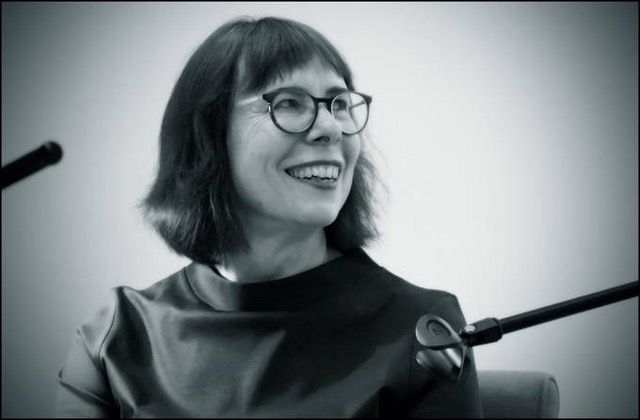„One, two, three, at a whizzing pace time runs; we run with it.“ (Wilhelm Busch). Frankfurt, innovation, resilience, and entrepreneurship – Markus Hill spoke with author Ortrud Toker for FINANZPLATZ-FRANKFURT-MAIN.DE about entrepreneurial personalities, inventiveness, and the historical significance of slowness, speed, and communication. Topics such as technology, inventiveness, and Prussia are addressed as well as data transmission, banking, and Frankfurt’s Paulskirche.
Hill: The Frankfurter Rundschau called your book „Vom Ende der Langsamkeit“ a public favourite, HR2 Kultur and Thalia recommend your book as a „Buchtipp“. Before Lockdown, you had many readings, including at the DenkBar, the Weltenleser bookshop and the Kulturfabrik in Sachsenhausen. What is your book about?
Toker: „The End of Slowness“ is about three extraordinary personalities of the 19th century. Werner von Siemens, Philipp Reis, and the couple Bertha and Carl Benz. They were all instrumental in groundbreaking inventions, namely telegraphy, the telephone, and the automobile. These inventions changed the world and still shape it today.
Hill: I see, it’s about entrepreneurial personalities. What do they have in common and how do they differ? Because I know two names, but I’m not familiar with Philipp Reis.
Toker: We are dealing with three completely different entrepreneurial characters. Werner von Siemens is probably the most popular and most influential. What distinguishes him is that he never lost sight of his goal, always remained curious, open, and above all flexible. He never allowed himself to be permanently discouraged by setbacks and defeats, but rather they spurred him on to achieve great things. In 1842, already as a young artillery officer, he used his imprisonment in Magdeburg prison, for example, for experiments that led to a significant discovery and his first patent. The beginning of a lifelong career, full of ups and downs. The Friedrichsdorf teacher Philipp Reis, on the other hand, was hapless and found no investors throughout his life. He died before the further development of his telephone began a worldwide triumphal procession. And what would have become of Carl Benz’s „Kutsch‘ ohne Gäul'“ if his wife Bertha had not tirelessly encouraged and supported him over the decades is written in the stars?

Photo: Hartmuth Schröder
Hill: So your book is also about the fact that inventiveness alone is not enough to be successful in the long run.
Toker: Absolutely. It’s commonplace that the gods put sweat before success. But what exactly that looks like and what it means in detail can be seen very clearly in these three CVs. Not only diligence and perseverance are an advantage, but also perseverance in achieving goals and a special resilience. Resilience refers to the ability to keep going after setbacks, to look forward like skipjack, and to learn productively from mistakes. The examples in my book show how this can be done. Every era needs clever, unconventional solutions, innovators, and visionaries. Entrepreneurs who burn for their goals, take calculated risks and assume responsibility. Only when innovative ideas are accompanied by the courage to implement them, openness, a sense of proportion, and staying power can they lead to long-term success. There are plenty of examples where perseverance has paid off. Today’s superstars are Steve Jobs, Elon Musk, and Jeff Bezos. But of course, people who have a smaller sphere of influence also know this.
Hill: Everyone talks about speed, but why do you talk about the end of slowness in your book?
Toker: In the inventions of the main characters in my book, Siemens, Reis, and the Benz couple, the acceleration of the transport of people and news plays a central role. But what exactly speed is and what significance it has in our society is constantly being redefined. In 1888, Bertha Benz needed a whole day to cover the 100 kilometers from Mannheim to Pforzheim in the first automobile. Her husband Carl Benz wanted to stop producing cars at a speed of 50 kilometers per hour.
Today, the new mobile radio standard G5 is about transmitting data speeds of up to 10 gigabits per second, which means communication in real-time and enables completely new applications. 100 billion devices would be addressable at the same time.
Hill: Fast data transmission was also politically and militarily relevant and still is today. Is that why Frankfurt’s Paulskirche also plays a role in your book?
Toker: Wired telegraphy was a brand-new technology in 1848/49 during the revolution. The Prussian king in Berlin wanted to be informed as quickly as possible about what was happening during the National Assembly in Frankfurt. Werner von Siemens was therefore commissioned to build the first European trunk line from Berlin to Frankfurt. When the National Assembly decided on 28 March 1849 to offer the imperial dignity to the king, the news travelled from Frankfurt to Berlin at the sensational speed of just one hour. If you think about it, we’re talking about a single wire, a cable connection on poles. That’s how it started back then. Today, Frankfurt is the location of Europe’s largest Internet node.
Hill: The financial world is also dependent on precise and fast data transmission – does Frankfurt have location advantages here historically?
Toker: Certainly, that is the point. My book is about the beginnings of accelerated communication, the first hot wire between Berlin and Frankfurt. There are famous precursors before telegraphy. At the beginning of the 19th century, the Rothschild banking family maintained their lofts for carrier pigeons on the roofs of their banking houses and used them to transport stock prices. In this way, they outflanked the competition.
Hill: That sounds like the motto „knowledge is power“.
Toker: Quite right. Nathan Mayer Rothschild knew before the British prime minister that Napoleon had been defeated at Waterloo and used this knowledge profitably for share trading. Carrier pigeons were also used by Julius Reuter in the mid-19th century for bridging purposes as long as the telegraph network was not yet fully established, even before he founded his news agency.
Hill: Thank you very much for the interview.
Ortrud Toker, born in 1957, studied art history, classical archaeology, and philosophy at the Johann Wolfgang von Goethe University in Frankfurt. She worked for many years at the German Film Museum and the Museum of Communication in Frankfurt, among others. Her focus is on early film and media history.
The book „Vom Ende der Langsamkeit“ (The End of Slowness) by Ortrud Toker is published by Henrich Editionen in Frankfurt: www.henrich.de)




3 Antworten auf „FINANCIAL CENTRE FRANKFURT: Paulskirche, Resilience, Silicon Valley & Slowness (Interview – Ortrud Toker, Author)“
Die Kommentare sind geschlossen.